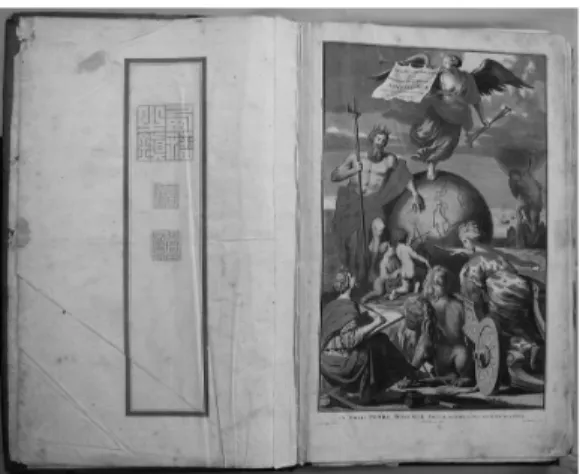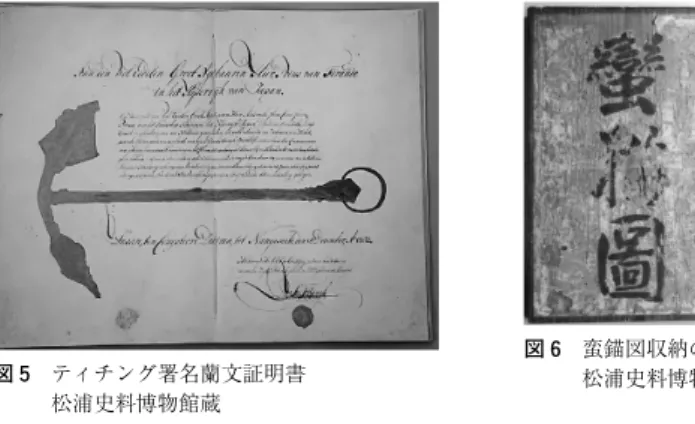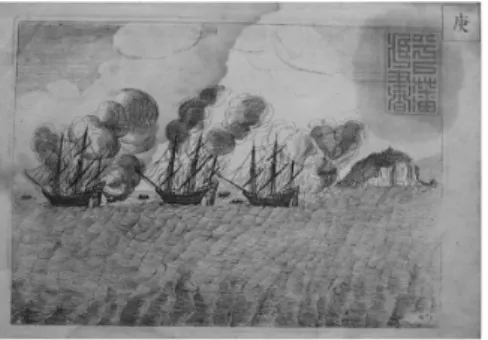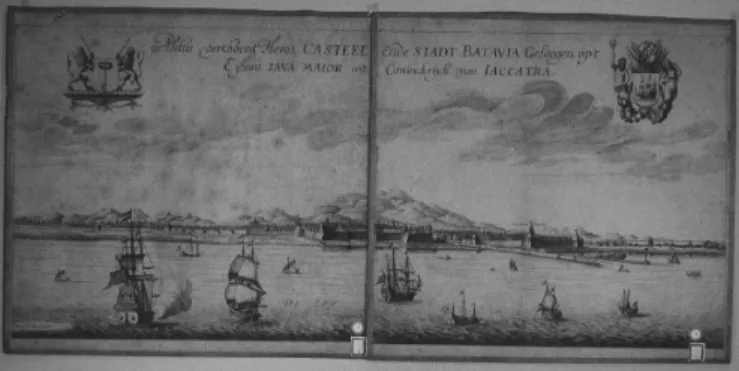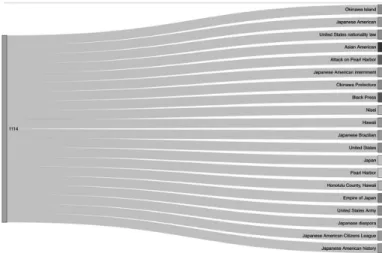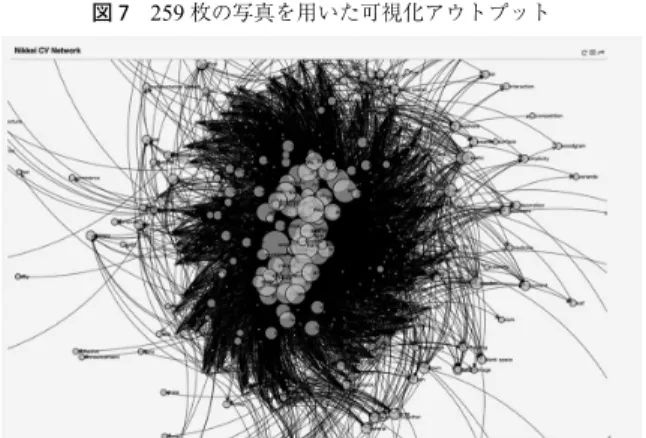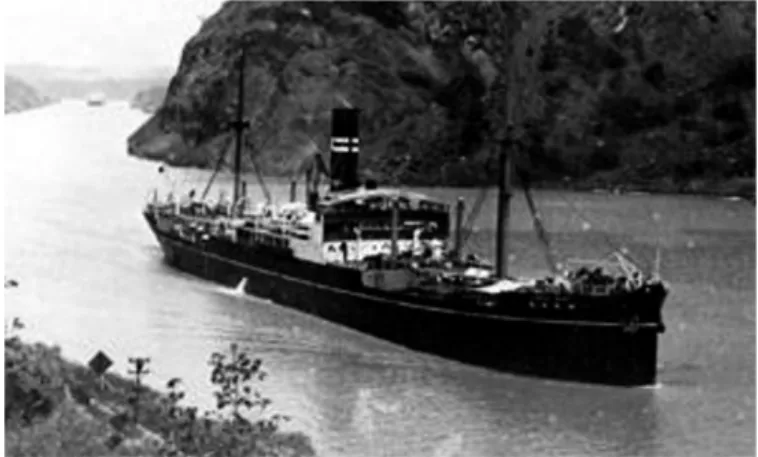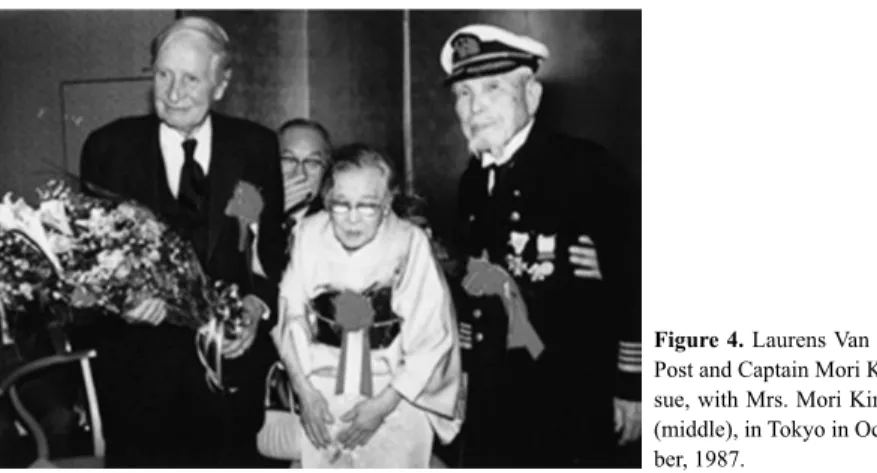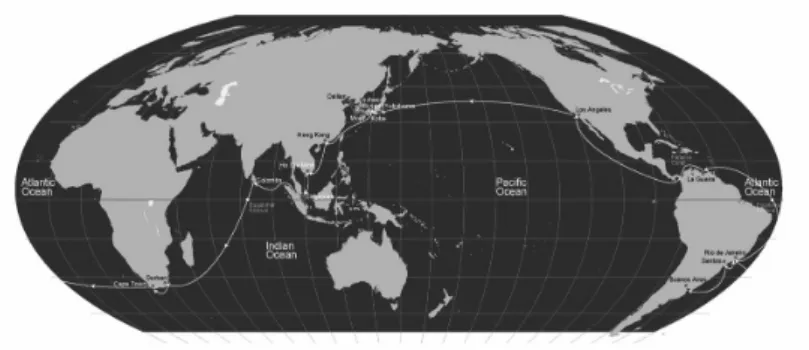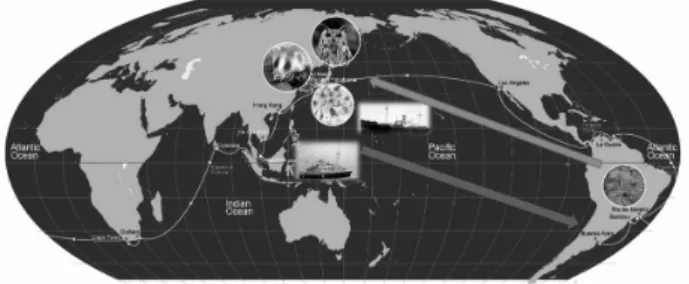Ed. by I
NAGAShigemi
Head of the Project Coordination Meeting–Suishinkaigi With the assistance of N
EGAWASachio
人間文化研究機構ネットワーク型基幹研究プロジェクト
「日本関連在外資料調査研究・活用事業」
プロジェクト間連携による研究成果活用 推進会議・
2019
年度事業報告論集Coordination between Projects to Make Effective Use of Research Results Network-based Projects: Japan-related Documents and Artifacts held Overseas
NIHU National Institute for Humanities
異文化へのあこがれEditor I
NAGAShigemi
稲賀繁美 ・編異文化へのあこがれ
─国際海洋都市 平戸とマカオを舞台に
─在外資料が変える日本研究─
稲賀繁美 編
Yearning for Foreign Cultures
An International Symposium in Hirado and A Panel in Macau
New Aspects of Japanese Studies based on Overseas Documents
Ed. by I
NAGAShigemi
Head of the Project Coordination Meeting–Suishinkaigi With the assistance of N
EGAWASachio
人間文化研究機構ネットワーク型基幹研究プロジェクト
「日本関連在外資料調査研究・活用事業」
プロジェクト間連携による研究成果活用 推進会議・
2019
年度事業報告論集Coordination between Projects to Make Effective Use of Research Results Network-based Projects: Japan-related Documents and Artifacts held Overseas
NIHU National Institute for Humanities
異文化へのあこがれ
─国際海洋都市 平戸とマカオを舞台に
─在外資料が変える日本研究─
稲賀繁美 編
Yearning for Foreign Cultures
An International Symposium in Hirado and A Panel in Macau
New Aspects of Japanese Studies based on Overseas Documents
序文 稲賀繁美
v
第I部:平戸国際シンポジウム編趣旨説明 稲賀繁美 1
松浦静山と平戸商館時代 松田 清 3
The VOC archives as a valuable source for the history of early modern Japan
Frederik Cryns & Cynthia Vialle 19 平戸に伝存する日蘭関係史料について─史料紹介─ 前田秀人 31 日本人による海外への移動に関する歴史記述を精緻化させる─日系関係在外資料を活用して─ 朝日祥之 37
平戸から新世界へ─山縣勇三郎のブラジル雄飛 根川幸男 49 レポート:国際シンポジウム国際海洋都市平戸と異文化へのあこがれ
─在外資料が変える日本研究─ 光平有希 63
平戸国際シンポジウム・プログラム
65
平戸国際シンポジウムの様子(写真)
66
第II部: ICLA編:Panel: Marine Vessel and Road as a Socializing Vehicle:
Enroute Experiences, Transnational Encounters and Exchanges
Introduction
Hashimoto Yorimitsu 75On the Marine Road: Anglo-Japanese Encounters and Exchanges in Modern Maritime Culture
Hashimoto Yorimitsu 79Under the Shadow of Apartheid: Maritime Paths of Transnational
Communication
Inaga Shigemi 95Crossing
“Manchukuo
”and Brazil: Migrant Vessels as Contact Zones
Negawa Sachio 109Navigating Between the West and the Rest: East Asia
ʼs modern Experience
in the Works of Enrique Gomez Carrillo (1904-1907)
Facundo Garasino 115
ICLA
発表の様子(写真)123
次世代の国際共同日本研究・研究協力への模索 稲賀繁美 129
Exploring International Team Research and Collaboration for Next-generation Scholars in Japanese Studies Overseas
Inaga Shigemi 130執筆者紹介
132
序 文 Preface
本報告書は、人間文化研究機構で第
3
期中期計画期間に推進されている「ネッ トワーク型基幹研究プロジェクト」を構成する17
におよぶ研究企画のうち、「日 本関連在外資料調査研究・活用事業」に属する「プロジェクト間連携による研究 成果活用」に関連する業績を、2019
年度終了時点での、前半期3
年の成果報告 の一環としてまとめた論集であり、これは2019
年度の事業報告の一部をなす。前半の第
1
部は、2019
年2
月9
日に、平戸市の平戸オランダ商館で、平戸市、(公 財)松浦史料博物館、平戸オランダ商館の共催のもとに組織した「国際海洋都市 平戸と異文化へのあこがれ─在外資料が変える日本研究─」での講演および発表 論文を中心に構成する。後半の第
2
部は、2019
年7
月31
日にマカオで開催された国際比較文学会ICLA: International Comparative Literature Association
の世界大会において、提 案のうえ採用されたワークショップMarine Vessel and Road as a Socializing Vehicle: Enroute Experiences, Transnational Encounters and Exchanges
での英文 発表を再録した。これらはともに、標記のプロジェクトの成果の社会還元・国際的な成果発信お よび一般市民を含む社会との学術交流の一環をなす。またその遂行にあたっては、
人間文化研究機構の特別経費の支給を受けた。最後に、本報告書に関連する企画 にご賛同・ご協力を得た各方面の機関にあらためて御礼の言葉を申し添える。
推進会議・総括責任者 稲 賀 繁 美
第 I 部:平戸国際シンポジウム編
国際シンポジウム
国際海洋都市 平戸と異文化へのあこがれ
─在外資料が変える日本研究─
2019 年 2 月 9 日
The International Symposium
The International Port City of Hirado
and its Interest in Foreign Cultures
1
趣旨説明
稲賀 繁美
(国際日本文化研究センター教授)
人間文化研究機構では、欧米に点在する日本関連資料のうち、学術的・社会的 に重要であるにもかかわらず、総合的な調査が十分でない資料を研究対象として 取り上げ、それらの資料を保存する国内外の研究機関、大学などと連携して調査 研究を行うことを目的とし、以下
4
つのプロジェクトを実施しています。1
. ハーグ国立文書館所蔵平戸オランダ商館文書調査研究・活用(国際日本 文化研究センター)12
. ヨーロッパにおける19
世紀日本関連在外資料調査研究・活用─日本文 化発信にむけた国際連携のモデル構築(国立歴史民俗博物館)3
. バチカン図書館所蔵マリオ・マレガ収集文書調査研究・保存・活用(国 文学研究資料館)4
. 北米における日本関連在外資料調査研究・活用─言語生活史研究に基づ いた近現代の在外資料論の構築─(国立国語研究所)5
. プロジェクト間連携による研究成果活用(国際日本文化研究センター)「日本関連在外資料調査研究・活用事業」と名付けられた事業であり、いずれ も人間文化研究機構における第
3
期中期計画に属するプロジェクトとして、2018
年度はその3
年目の折り返し地点を迎えます。これらの事業統括を担当するプロジェクト間連携による研究成果活用班(国際 日本文化研究センター)は、他のプロジェクトと連携するとともに、歴史的・地 理的な軸によって各プロジェクトを縦断・横断する視野を確立し、個別の学術成 果をより効果的に活用するとともに、広く国内外の社会一般への普及につとめて います。そして、これを通じて、海外の若手研究者の問題意識に点火すること、
日本に関する情報の国際的流通のありさまを歴史的・地理的に復元するとともに、
日本国外になお埋もれている未発見の資料、未研究の文書などの将来の発見に向
1「ハーグ国立文書館所蔵平戸オランダ商館文書調査研究・活用」は、2018年度まで。
2 団の構築を目指しています。
今回、平戸市及び(公財)松浦史料博物館、平戸オランダ商館の全面的なご協 力をいただき、同プロジェクトの中間的な成果を、研究者や社会一般、とりわけ ハーグ国立文書館所蔵平戸オランダ商館文書調査研究・活用プロジェクトと関連 する歴史的な場所である、平戸の皆様にご披露する機会を得ました。
本シンポジウムでは、プログラムのように、平戸オランダ商館文書をふくめ、
この時期の日欧交流研究の泰斗、京都大学名誉教授、松田清先生をお呼びしてご 講演をいただきました。
また、オランダ・ハーグ文書館に保存されてきた、平戸関係文書の解読をすす めてこられた、フレデリック・クレインス先生、ライデン大学のシンティア・フ ィアレ先生からの詳しいご報告も含まれております。その他、大分でのキリシタ ン弾圧や宗門人別改め関連文書の収集であるマレガ文書については、京都外国語 大学のシルヴィオ・ヴィータ先生からの報告、一昨年、全国を巡回したシーボル トの遺品復元の展覧会に関連する国立歴史民俗博物館の福岡万里子准教授の報告、
国立国語研究所の朝日祥之准教授より北米移民関係の報告、そして国際日本文化 研究センターの根川幸男機関研究員による平戸の風雲児・山縣勇三郎のブラジル 雄飛についての報告など、充実した日程を組むことができました。
この国際シンポジウム開催に際しましては、平戸市及び(公財)松浦史料博物 館、平戸オランダ商館のご協力を仰ぎました。ここに関係者および、平戸市の皆 様に厚く御礼を申し上げるとともに、多くの方々の御来席に、あらためて感謝の 気持ちをお伝えする次第です。
なお、本報告書には、当日の講演・発表のうち、原稿を頂戴できたものに限り 掲載しております。年度末予算処理の時間的制約ほか、諸般の事情により、すべ ての報告を掲載できませんでしたことを、一言お断り申し上げます。
3
松浦静山と平戸商館時代
松田 清
(神田外語大学客員教授)
1
.好学大名松浦静山の修史観(注1)平戸松浦家
34
代、平戸藩9
代藩主、松浦清(1760
〜1841
)は安永4
年(1775
) に16
歳で家督を継ぎ、安永8
年(1779
)20
歳で「楽歳堂」文庫と藩校維新館 を建て、自ら『大学』を講ずるなど、文教に力を注いだ。天明3
年(1783
)10
月17
日、参勤の途上、大坂で京都の儒者皆川淇園に会い、師の礼をとった。時 に静山23
歳、淇園50
歳。同月20
日近臣の長村内蔵助(鑑、靖斎)17
歳を入 門させ、寛政3
年(1791
)11
月15
日には自ら32
歳で淇園に贄を納めた。文化2
年(1805
)3
月には嗣子熈ひろむを15
歳で入門させ、翌年47
歳で家督を熈に譲り、静山と号して隠居した。
好学の静山は隠居後も学問を続け、文政
4
年(1821
)から執筆を始めた記録 集『甲子夜話』全278
巻と、生涯を掛けて和漢洋の文物を集めた「楽歳堂」文 庫は静山の文化的二大遺産となっている。静山は後世に伝えるという明確な目的 をもって、耳目に触れたあらゆる事物を記録し、内外の文物を収集した。静山は天明
4
年(1784
)修史館「緝熈斎」を設置し、自ら総裁として家史編 纂を主導した。「緝熈」には光輝ある事蹟を編輯するという意味が込められてい ただろう。平戸藩初代鎮信(法印)から4
代鎮信(天祥)に至る平戸商館時代(1609
〜
1641
)は国際貿易港として栄えた平戸の黄金時代であり、静山はこの時代の 家史に力をそそぎ、歴史的証言を外国資料にまで求めた。天明期は薩摩藩主島津重豪や福知山藩主朽木昌綱など、いわゆる蘭癖大名(注2) が海外の文物を収集し、蘭学者を庇護していた。静山も参勤のたびに長崎に滞在
1 本稿は2019年2月9日に行った本シンポジウムの基調講演「松浦静山と平戸商館時 代」の概要をまとめたものである。本稿に引用する一次資料は特に所蔵先を示す場合 を除いて、すべて松浦史料博物館所蔵である。
2 他に、佐伯藩主毛利高たか標すえ、桑名藩主松平忠ただ和とも(もと紀州家徳川賴より徳やす)がいる。
するとともに、本木良永や吉雄幸左衛門など、先祖が平戸藩に仕えた長崎の有力 な阿蘭陀通詞を家臣のように遇し、彼らを通して貴重な蘭書を数多く入手し、海 外情報を集めた。入手した貴重蘭書には「楽歳堂図書記」の印のほかに、「西藩 之鎮」(図
1
)や「子孫永宝」の印を捺した。「西藩之鎮」は日本の西の守りを固 める平戸藩を意味する。静山にとって修史は儒教的な「孝」の実践、すなわち、先祖の輝かしい事跡を 明らかにし、子孫に伝えることに他ならなかった。その考えは静山が編纂し、そ の遺志を継いだ熈が校訂した家史の書名『敬孝述事』(注3)にも表れている。「敬孝 述事」とは先祖を敬い、先祖に仕えて、その事蹟を述べる、という意味である。
そのような静山の儒教的修史観は、長村鑑が「静山公行実」(文化
10
年成)で 引用する天明2
年の静山の言葉によく表れている。天明二年壬寅公曰く、古の君子、其の先祖の徳善功烈有るを論譔し、諸これを天 下に列し、諸を後世に伝へ、以て其の美を顕揚するは、孝を崇ぶ所以なり。
善あるも知らず、知るも伝へざるは、不孝焉これより大なるは莫し、と。乃ち修 史の志を興し、親みずから祖服[先祖の事蹟─引用者注]を纂し、始めて稿を起
図2 P. Schenck, Atlas contractus. Amsterdam. c. 1700.
松浦史料博物館蔵
図1 「西藩之鎮」印(図2部分)
3 全49巻。静山の遺志を継いで松浦熈が校訂し、安政4年3月17日に総目録(巻 49)を作成した。
松浦静山と平戸商館時代 5 す。其の法は先ず統系を作り、繋ぐに其の事蹟を以てし、断簡欠牘の文を歴 拠し、散漏逸脱の事を捜索す。行余は必ず焉に従事す。夜半に至り、乃ち輟や む。(原漢文)(注4)。
儒教的修史観は、静山の師事した皆川淇園や親交のあった昌平黌の林述斎も共 有していたであろうが、静山の場合は特に、生涯座右に掲げ、拳々服膺した祖母 久昌夫人の遺訓十条が決定的だったようだ。第一条に「神仏常に御信心御志の御 事」、第二条に「御先祖御大事に御心懸之御事」、第三条に「物毎御堪忍第一之御 事」とある。
2
.天明期収集の平戸商館時代資料静山は修史のため、阿蘭陀通詞や商館長ティチング、蘭癖大名朽木昌綱などか ら、平戸商館時代と見なす資料を熱心に収集した。
この収集においてティチングが果たした役割は大きい。静山はまず、日本を追 われた異邦在住者が制作したらしい南蛮鉄の刀鍔(伝存せず)を、江戸滞在中の ティチングから贈られた。また、天明
2
年1
月17
日(1782
年2
月28
日)に平戸の川か わ ち内浦うらからヨーロッパ製の大錨が引き上げられると、さっそくそれを城内に
取り寄せて絵師に『蛮錨図』(松浦史料博物館蔵)を描かせ、平戸商館時代のオ ランダ船の錨であることをティチングに証明させた。さらに英国王ジェームズ
1
世の銅版肖像図(松浦家蔵)を入手し、阿蘭陀通詞本木良永にそのラテン語題字 の翻訳を命じた。本木良永のために題字のオランダ語訳を教えたのはティチング だった。本木良永はまた、静山が入手したコメリン編『オランダ東インド会社の起原と 発展』(アムステルダム、
1645
)の図版8
葉(松浦史料博物館蔵)の解題を命ぜ られ、おそらくこれもティチングの協力を得て行うことが出来た。静山はおそら く天明期にヨハネス・デ・ラム刊行の長大な銅版『バタヴィア景観図』(国立科 学博物館蔵)も入手した。天明
6
年11
月には、長崎で阿蘭陀通詞吉雄幸作(幸左衛門)から西洋船旗集『異4 原文「天明二年壬寅公曰、古之君子論譔其先祖之有徳善功烈、列諸天下、伝諸後世、
以顕揚其美、所以崇孝也、有善而弗知、知而弗伝、不孝莫大焉、乃興修史之志、親纂 祖服、始起稿、其法先作統系、繋以其事蹟、歴拠断簡欠牘之文、捜索散漏逸脱之事、
行余必従事焉、至夜半、乃輟」
国旗標』(国立科学博物館蔵)を購入し、翌天明
7
年6
月には参勤の途上、京都 で松浦家の御用達商人猪飼太右衛門から「遊女之図」屏風(所謂『松浦屏風』、国宝、大和文華館蔵)を贈られ、平戸商館時代の日本の古風俗に強い関心を寄せ た(注5)。
天明
7
年末、静山はアベ・プレヴォー編訳『旅行記集成』(パリ版)のオラン ダ語版(ハーグ・アムステルダム版、1747-1767
刊、21
巻)をいち早く入手し た朽木昌綱から、そのなかに平戸商館時代の英船平戸入津記事のあることを知ら され、早速その翻訳を昌綱に依頼した。第2
巻(ハーグ、1747
)には平戸商館 時代の記録であるジョン・セーリス『日本渡航記』およびリチャード・コックス『イギリス商館長日記』のオランダ語抄訳が収録されていたのである。
天明
8
年春には静山も長崎から、『旅行記集成』オランダ語版(阿蘭陀通詞楢 林重兵衛旧蔵19
冊本、うち16
冊が松浦史料博物館蔵)を入手した。昌綱は静 山の依頼を受けて、所蔵本第2
巻の平戸商館関係記事の抄訳を進め、翌年(寛政 元年)までに『蘭書和解』を静山に送ったらしい(注6)。静山が天明期に収集した以上の平戸商館時代資料のうち、南蛮鉄の刀鍔、蛮錨 図、コメリン『オランダ東インド会社の起原と発展』の銅版図、英国王ジェーム ズ
1
世肖像図、バタヴィア景観図、異国旗標を以下に、資料写真とともに、個別 に考察しよう。3
.南蛮鉄の刀鍔松浦静山は『甲子夜話』三篇巻十五(松浦史料博物館蔵写本)で「予ガ佩料ノ 刀ノ鍔ハ大小トモ世ニ南蛮鉄ト謂フモノナリ、迺チ図ノ如シ」として大刀、小刀 それぞれの鍔図(図
3
)を掲げ、「大ノ方」は「径二寸五歩強/厚二歩/重三十 六匁一分」、「小ノ方」は「径同上/厚同上/重三十八匁八分」と計量を示す。この刀鍔は静山が「壮年に及ばん」とする頃、参府した商館長ティチングが火
5 松田清「国宝『松浦屏風』の由来─松浦静山収蔵の経緯について─」(『平戸紀要8号』
平戸市編、2020年3月)参照。
6 松浦静山は朽木昌綱から『蘭書和解』を受け取ったあと、第2巻所収の同じ平戸商 館関係記事の新訳をおそらく文化初年までに作らせ、『敬孝述事』に編入した。この 新訳の訳者は蘭学者志筑忠雄と推定される。詳しくは、松田清「セーリス平戸入津記 事翻訳考─朽木昌綱訳『蘭書和解』から『敬孝述事』へ─」(『平戸紀要8号』平戸市 編、2020年3月)参照。
松浦静山と平戸商館時代 7
災で浅草寺に避難したところを、夜間お忍びで訪ねた際に、ティチングから贈ら れたものという。ティチングは「禁制品と知りながら日本に携行した、オランダ 人の『渡舶旧恩の国』平戸の藩主である貴方に差し上げる」と打ち明けたという。
商館長ティチングの江戸滞在は
1780
年3
月26
日〜4
月14
日(安永9
年2
月21
日〜3
月10
日)および1782
年4
月7
日〜4
月22
日(天明2
年2
月15
日〜3
月10
日)の2
回であったが、いずれも静山の在国時期にあたり、江戸不在であっ た(注7)ので、謎が残る。いずれにしても静山は後に、なじみの博識な仏教学者荻 野梅塢から、異邦在住の日本人による制作であるとの証言を得て、『甲子夜話』に書き入れた。
先年参府の阿蘭陀人、其頃寄宅の坊まち焼亡の患ありて、蘭人浅草寺の境内に寓 す。余其頃は壮年に及ばんときにて、夜中潜行してその旅舎に往見る。加比 丹名を「テツチンギ」と称す。この人今に世の識る者なり。迺ち通詞に憑て、
客は予なることを聞き、敬礼の状甚至れり。予も亦愛語を交ること数刻、「テ ツチンギ」立退き行李と覚しき物あるを啓き、其内底中に有るものを捜、持 て予が前に進み曰ふ、この品は表向きに云ふ可からざる物にして、某密に持 渡れり。惟君侯は吾が蛮渡舶旧恩の国なれば、其古を忘れざるを示す。この 巧作の出る所は貴国に於て嫌疑あり、因て竊に携来るを、今君公を見て奉る
7 「静山公実録 上」(松浦史料博物館蔵)による。
図3 南蛮鉄の刀鍔 甲子夜話 松浦史料博物館蔵写
と。
又或人曰ふ(梅塢)此「テツチンギ」が上りし鍔は正しく吾国人の末、異邦 に在る者の造りし物なり。この異邦に在る者の制せること、世に知る者有り と。
4
.蛮錨図天明
2
年1
月17
日(1782
年2
月28
日)、平戸商館時代に貿易港として栄え た平戸の川内浦(当時の表記は河内浦)の湾内から、西洋製の大錨が引き揚げら れるや、静山は城内に運ばせ、同月25
日に実見した。このとき作成された「天 明二寅正月十七日河内浦より揚碇之絵図」(原寸大、図4
)を計測すると、錨環 内径42.5cm
、錨幹400cm
、錨爪の両先端間239.3cm
である。本木良永は静山の命を受けて、絵師に全体の彩色縮小図をオランダ製洋紙に描 かせ、錨発見の経緯を書き入れた自筆の「
Aan den Wel Eedelen Groot Agtbaaren Heer, Prins van Firando, in het Kijserrijk van Japan
」(日本国平戸侯尊大敬君あて)オランダ語証明書を作成し、ティチングへ証明書に署名するよう求めて書簡を送 った。
1782
年12
月18
日付けのその書簡は次のような文面だった。学士イサーク・ティチング殿
平戸侯尊大敬君のご命令により、オランダ甲比丹イサーク・ティチング殿 のために、オランダ錨の図を載せた書冊から数条の内容を、私こと小通詞本 木栄之進が翻訳いたしました。この錨はオランダ暦
1782
年日本の第1
月す なわち正月に平戸国の河内浦湾の海底から引き揚げられました。しばらく前 の出来事ですが、他国の船が大勢の人々を乗せて河内浦へ入港し投錨したも図4 河内浦より揚碇之絵図 部分 松浦史料博物館蔵
松浦静山と平戸商館時代 9
のの、錨を再び挙げることができなくなりました。そのため潜水夫とともに 湾の海底を捜索しましたところ、和製の錨と一緒に、ここに描いたオランダ の錨が海中から引き揚げられました。これは、その図の形態からオランダの 錨と確かに本当に一致しております。こういうわけですので、閣下、もちろ ん閣下のお気持ち次第ではありますが、オランダの錨であることを証明して いただくご署名を賜り、朱のご封蝋を捺して下さいますよう、署名者よりお 願い申し上げます。
頓首再拝 閣下の卑僕なる
1782
年12
月18
日 本木栄之進ティチングが署名し、赤ラックの落款を押した証明書(図
5
)は前後に漢文の 由来書と寸法書を配した冊子に装丁され、『蛮 図』と題されている。この冊子 は蘭文の釈文、漢文のオランダ語訳とともに、蓋に『蛮猫図』(図6
)と墨筆大 書した木箱に納められている。5
.銅版図8
枚静山が入手した銅版図
8
枚はイサーク・コメリン(1598
〜1676
)が編集した 旅行記集『オランダ東インド会社の起原と発展 第2
巻』(Isaac Commelin, Tweede deel van het begin ende voortgangh der Vereenighde Nederlantsche Geoc- troyeerde Oost-Indische Compagnie. Amsterdam, Jan Jansz., 1645/1646.
)所収の 旅行記3
種から抜き取られたもので、静山はこれに甲乙丙丁戊巳庚辛の記号を配図5 ティチング署名蘭文証明書 松浦史料博物館蔵
図6 蛮錨図収納の木箱 松浦史料博物館蔵
し、自筆の目録(図
7
)を作成して愛蔵した。おそらく舶載されたコメリンの原 書の行方は不明である。静山は目録の末尾で、題は阿蘭陀通詞本木栄進(栄之進)すなわち良永の話に よると記し、おそらく良永は「蛮人」の「口授」から解題を得ただろうと推測し ている。しかし、図の典拠となった旅行記の原文と照合した結果、良永は単独で 原文を参照し、難解な部分は推測も交えて解題したと考えられる。典拠となった 旅行記と各図の原文キャプションの和訳を静山の付けた記号とともに掲げよう。
1
.ステーフェン・ファンデル・ハーヘン(Steven van der Hagen
)提督の第2
回東インド航海記[1604
〜1607
]「
No.6.
ベグー(Pegu
)国王の壮麗な宮廷およびその巨大な白象の図」(丙)図
7松浦静山筆銅版図目録
甲 咬 ︵バタビヤ︶𠺕吧近地アンホン島小城図︵図
庚蛮舶洋中ニテ仏狼機ヲ放スル図︵図 巳漢土海舶図 戊琵牛国人象ヲ以テ戦図 ヲ捕ル也蓋一象怒ル時ハ衆人敵シ難シ ナレバ見自由ナラサルニ乗シテ象奴之 圏ニ入テ向ノ狭キ口ヨリ出ルトキ大獣 喇叭ヲ吹クハ其音ニテ象ヲヨセル也象 丁琵牛国象ヲ牧スル図 ノ方ニアルハ象ノ王ニ礼スル也 故炎日ヲ遮ガ為也愛象ナレバ也○上 琵牛ハ天竺ノ名象ニ蓋スルハ琵牛熱国 丙琵牛国王白象ヲ愛スル図 乙アンホン島小城図背面図 8︶ 9︶ 小舟モ亦蛮人ノ乗スル所也辛 又蛮舶図也︵図
10︶
︵方印楽歳堂説本紙ニ貼シテアリ 図書記︶右阿蘭陀訳師本木栄進所話蓋得之于蛮人口授云 ︵図
7の釈文︶
松浦静山と平戸商館時代 11
「
No.7.
ペグー国王とアワ(Auua
)国王の戦闘の図」(戊)「
No.8.
象狩りの図」(丁)2
.小コルネリス・マーテリーフ(Cornelis Matelief de Jonge
)提督の1605
年・1606
年・1607
年・1608
年における東インドおよびシナ航海記「
No.3.
マラッカ沖で座礁し自船の火ほ く ち口で炎上するガリオン船3
艘」(庚)「
No.5.
1607
年のアイボイナ城の図」(甲)「
No.6.
海側および船上からみたアイボイナ城」(乙)「
No.10.
シナのジャンク船図」(巳)3
.ピーテル・ファン・デン・ブルッケ(Pieter van den Broecke
)のカーボベ ルデ、アンゴラ、ギニアおよび東インド航海記図8 アンボン島城図(甲)
図9 炎上するポルトガルのガリオン船(辛)
図
隊のテッセル島帰着図 10 ピーテル・ファン・デル・ブルッケ艦
「
No.12.
艦隊図」(辛)ビルマ(ミャンマー)のペグー(現在のバゴー)にあった王国に関する「丙」
「戊」「丁」
3
図はフランクフルトのデ・ブリ書店刊『東インド紀行集』第7
巻(
Indiae Orientalis pars septima. Frankfurt, Joh. Th. & Joh. Isr. de Bry, 1606.
)所収、ベネチア商人ガスパロ・バルビ(
Gasparo Balbi
)の1579
年ペグー滞在記が典拠 である(注8)。「庚」図は、
1606
年10
月31
日のマラッカ沖海戦でポルトガル人がオランダ 艦隊に自船を捕獲されないように自船を炎上させて退去する図である。「蛮舶洋 中ニテ仏( ふ ら ん き )狼機ヲ放スル図 小舟モ亦蛮人ノ乗スル所也」との解題は推測による。
「辛」図は
1629
年12
月15
日、バタヴィアで東インド総督スペックス(Jacques
Specx
)から艦隊司令官に任命されたファン・デン・ブルッケが1630
年6
月6
日にオランダ・テッセル島に帰着する図である。
6
.英国王ジェームズ1
世肖像図イギリス東インド会社船グローブ号の司令官ジョン・セーリスは英国王ジェー ムズ
1
世の徳川家康宛書簡を携えて、1613
年6
月11
日平戸に入港した。静山は 天明8
年から翌寛政元年にかけて、朽木昌綱の翻訳『蘭書和解』によって、プレ ヴォー『旅行記集成』オランダ語版所収のセーリス平戸入津記事のあらましを知 ることが出来た。また、天明8
年正月に昌綱から、松浦鎮信法印のジェームズ国 王あて慶長8
年10
月6
日付け書状の写しを贈られている。しかし、これより早く、静山は英国王ジェームズ
1
世の銅版手彩色肖像画(図11
、額装、本紙縦30.7cm
×横
18.6cm
)を入手し、本木良永にそのラテン語の題字を解題させた。その解題にあたって良永は商館長ティチングの教示を得ているので、静山の肖像画入手 はティチングが最終的に離日する
1784
年11
月29
日(天明4
年10
月17
日)以 前にさかのぼる。銅版肖像画を納めた杉箱の蓋(横
40cm
×縦27.8cm
)には本木良永が肖像画 のラテン語題字とその蘭訳「IACOBVS DEI GRATIA MAGNAE BRITANNI [AE] FRAN / CIAE ET H [IBER]NIAE RE [X], FIDEI DEFENSOR etc. / Jacobus Door gods genade koning van Engeland, vrankrijk en [ie] rl [an] d, beschermen
8 Michiel van Groesen, The Representations of the Overseas World in the De Bry Col- lection of Voyages (1590-1634). Brill, 2012. pp. 424-425. 参照。
松浦静山と平戸商館時代 13
[sic] van
ʼt Geloof.
」(神の恩寵を受けたイングランド、フランス、アイルランドの王、信仰の庇護者ヤコブス)をペン書きで転写した洋紙が貼られている。肖像 画の額裏(図
12
)には本木良永が題字の釈文を洋紙に墨書して貼り付けている。その翻刻は以下の通り。
図11 ジェームズ1世肖像画
松浦家蔵 図12 ジェームズ1世肖像画 額裏
︵額裏釈文の翻刻︶
釈文はティチングから教示を受けたラテン語題字の読み方(フランス語読音)
とオランダ語訳とその読み方(阿蘭陀語読音)を片仮名で示し、最後に訳文を掲 げている。翻訳の際、原文の一部「
FIDEI DEFENSOR
」(蘭訳beschermer van
ʻt
Geloof
、「信仰の庇護者」の意)は意図的に訳出しなかったようだ。7
.バタヴィア景観図銅版
2
枚続の本図(図13
、縦465cm
×横980cm
)を納める木箱の蓋の側面(図14
)には、「[爪]哇嶋中咬𠺕吧國之所属婆哆婀臂耶城市圖」との題名を墨書し た貼紙がある。静山自信が編纂した「平戸藩楽歳堂蔵書目録」(京都大学付属図 書館所蔵、大正写本)では、本図の原タイトル「Aldus vertoont Hem
ʻt Casteel Ende Stadt Batavia Geleegen op
ʼt Eylant Iava Major in
ʼt Coninckryck van Iacca- tra.
」の一語一語に阿蘭陀通詞(未詳)が訳語を付け、「ヤカタラ國府城ノ地ヤハ マヨル島ニ属ル城及市陌ノ風景ヲ画ル圖」との題名を与えている。本図の左下角に「
Iohannis de Ram Excudit.
」(ヨハネス・デ・ラム刊)、右下 角に「I. vinckeboons Fn [sic].
」(I.
フィンケボーンス刻)、中央下部に「Iulius
Mülh: f.
」(ユリウス・ミュルフーセル画)の署名が刻まれており、制作年代1619
〜1680
年とされるアムステルダム国立博物館所蔵「バタビア景観図」図13 バタヴィア景観図 銅版図版2枚続 国立科学博物館蔵
図14 バタヴィア景観図の箱蓋 国立科学博物館蔵
松浦静山と平戸商館時代 15
Gezicht op Batavia. Rijksmuseum Amsterdam, RP-P-1975-226
)と一致する。天明期舶載のファレンテイン『新旧東インド誌』第
4
巻(F. Valentijn, Oud en Nieuw Oost-Indiën. IVde deel. Dordrecht, Amsterdam, 1726.
)233
ページには、「バ タビアの眺望」(Batavia in
ʻt verschiet.
)と題して本図と同巧の折り込み銅版図 版(無署名)がみられる。朽木昌綱はティチング宛天明5
年4
月20
日付の蘭文 書簡で、この地図・図版の豊富な東インド全誌を注文しているが入手できたか分 からない。天明期に最も早く入手したのは阿蘭陀通詞吉雄幸左衛門であろう。そ の所蔵本が伝わる。静山はこのヨハネス・デ・ラム刊の本図によって、1619
年 建設のバタヴィア城の景観を知り、平戸商館時代に思いを馳せたであろう。8
.異国旗標静山は天明
6
年(1786
)夏、長崎でこの西洋船旗図集を入手し、巻子仕立て にした。紙本著色、紙高25.5cm
、長さ445cm
の1
巻に、船旗図計202
図を収 録し、各図の右には国名などの解説文が墨書されている(図15
)。巻頭の自筆の識語によれば、静山は由来不明の「旗標図」を楽歳堂文庫に所蔵 していたが、新たなこの「旗標図」と比較すると既収のものは誤りが多く、新収 のものがはるかに優れていた。しかし、
図が
11
図不足していたので、これを新 収のものに追補したという。実際、この 巻子の末尾をみると、冒頭から191
図 は一連の彩色図であるが、「以下十一図 旧蔵ノ本ノ図」と墨書したあと、紙を付 け足し、少し異なる色合いで11
図が追 加されている。静山はこれより先の年に、長崎の阿蘭陀通詞吉雄幸作(幸左衛門)
のところで欧人の手になる「諸国旗標ノ 図」を見せてもらったが、新収品は幸作 のものと同一内容かどうか不明であると いう。
静山は本報告の始めに指摘したように、
入手した貴重蘭書に「西藩之鎮」という 蔵書印を押し、藩主として国防の任にあ
ることを自戒していた。この識語におい 図15 異国旗標(部分)国立科学博物館蔵
ても、「凡藩屏ノ任或犯寇ノ賊アランニ須先此旗標ヲ認得テ外洋何レノ国ト云コ トヲ知ルベシ」と自戒の言葉を加えている。静山はオランダ語を読むことはでき なかったが、収集した蘭書の図版や挿絵にはよく目を通していたようで、とりわ け十字架の図には強い関心を寄せていた。この「異国旗標」についても、「十字 アル者ハ皆其国人天主教ヲ奉ル者也」と吉雄幸左衛門の説明を記している。静山 の識語全文を以下に翻刻しよう(句読点は引用者)。
幕末に多くの西洋船旗図集が写本や刊本で流布したが、この「異国旗標」は最 も古いものと思われる。典拠となった蘭書は、アラルト『新撰オランダ造船術』
(
Carel Allard, Niewe Hollandse scheeps-bouw. Amsterdam, C. Allard, 1695-1705.
8vo. 2 vols.
)である。おそらく長崎の絵師が原書の銅版手彩色図版を模写し、阿蘭陀通詞が本文の解説を翻訳して書き入れたものであろう。
おわりに─在外史料の活用─
以上、考察したように、静山の修史観は儒教的な先祖崇拝に基づくもので、修 史の目的は資料や記録を文化遺産として子孫・後世に残すことであった。静山が 天明期に家史編纂を始めるにあたって、商館長イサーク・ティチングと阿蘭陀通 詞吉雄幸左衛門および本木良永は平戸商館時代関係資料収集に大きな役割を果た した。
一方、ティチングは
1779
年から1784
の間に3
度にわたって、都合4
年近く一旗標図旧ヨリ予庫ニ蔵ル者一巻︑其得シ所ハ詳ナラス︒今年夏︑崎ニユキテ又一巻ヲ得リ︒携帰テ蔵ル所ト比ルニ其図最勝リ︑旧蔵ル所ノ本ハ拙工ノ画ク所ニ シテ誤謬甚多︒然トモ崎ニ得ル所ト校ルニ︑無キ者十一ヲ得リ︒因テ其有ル所ノ者ヲ巻尾ニ補入ル︒其図誤謬有ンモ︑外域徴ルニ由ナシ︒故ニ一ニ旧ノ図ニ依也︒一凡此旗標︑外域絶遠知ル可ラス︒故ニ或ハ吾邦ノ人︑虎豹犀象ヲ画ノ類トセン者有ン︒然トモ予先ノ年︑崎ニ往テ訳人吉雄幸作ノ蔵ル所ノ諸国旗標ノ図ヲ視タリ︒即蛮人ノ画ク所︒コレニ依レハ今得ル所ノ図︑吉雄カ蔵ル所ト同物ナルヲ知サレトモ︑全是蛮人ノ手ニ出ル所ニシテ謄写ノ伝シ也︒凡藩屏ノ任︑或犯寇ノ賊アランニ須先此旗標ヲ認得テ外洋何レノ国ト云コトヲ知ルベシ︒コレ信ニスル所也︒一幸作曰シハ︑凡此旗ノ章ニ十字アル者ハ皆其国人天主教ヲ奉ル者也︒
天明六年丙午冬十一月源清書︵印︶︵印︶
松浦静山と平戸商館時代 17 日本に滞在し、多数の日本資料をヨーロッパに持ち帰ったが、
1812
年パリで客 死するや、その日本コレクションはヨーロッパ各地に散逸した。ティチングの伝 記研究と日本コレクションの書誌的再構成はフランク・レクインの長年の努力に よって大成を見た(注9)が、日本人研究者による、各資料の本格的な調査研究を今 後さらに進める必要がある。9 Frank Lequin, Isaac Titsingh (1745-1812). Een passie voor Japan. Leven en werk van de grondlegger van de Europese japanologie. Leiden, 2002. Id., A la recherche du Cabi- net Titsingh: its history, contents and dispersal. Catalogue raisonné of the collection of the founder of European Japanology. Alphen aan den Rijn. 2003.
19
The VOC archives as a valuable source for the history of early modern Japan
Frederik C
ryns(Nichibunken)
Cynthia V
ialle(Leiden University)
Introduction
1Relations between Japan and the Netherlands officially began in 1609 when the Dutch East India Company (VOC) received permission to establish a trading facto- ry on Hirado. In 1641 the factory and its personnel were moved to Deshima in the harbour of Nagasaki, where the Dutch remained until 1859. As part of a large trad- ing organization, the Dutch factories both on Hirado and on Deshima were obliged to maintain a regular correspondence with the other settlements in Asia and report to their superiors in Java and the Netherlands. Apart from documenting trade and matters relevant to it, the factories were required to keep track of events and hap- penings elsewhere in Japan, noting them in dagregisters (daily registers, diaries).
Consequently, the Japan factory dagregisters contain valuable information about Japanese history, society and culture.
The archives of the Hirado and Deshima factories are collectively known as het archief van de Nederlandse factorij in Japan (the archive of the Dutch factory in Japan). They are preserved in the Nationaal Archief (the National Archives of the Netherlands) in The Hague. They are kept as a separate archive, although they are part of the larger archive of the VOC, also housed in the Nationaal Archief. The
1 This article is based on presentations given at the VOC symposium ʻRethinking the Dutch East India Company (VOC): Old genres, new trends in research and analysisʼ (The Hague, 23 November 2017), and the international symposium ʻThe International Port City of Hirado and its Interest in Foreign Cultures-Foreign Sources Changing Jap- anese Historical Researchʼ (Hirado, 9 February 2019).
VOC archive also contains many documents relating to Japan.
The archives of the Japan factory and the VOC are the most important sources for reconstructing the history of the intercourse between Japan and European countries from 1609 until 1853, when Japan was opened to other Western nations. Japanese, Chinese, English, Portuguese and Spanish sources also exist, but VOC sources ex- cel quantitatively.
This article will address differences between Dutch and Japanese sources and also give an overview of how the Dutch sources are used in Japan and the challenges we face in promoting the use of the VOC sources among Japanese historians. Fi- nally, it will discuss the contents and the goal of the Hirado Project to make this part of the VOC archives accessible to the scholarly community.
Differences between Dutch and Japanese record keeping
The VOC was a large trading company and therefore it was of the utmost impor- tance to keep good records of all its business transactions and assets. Six chambers
̶
based in the cities of Amsterdam, Middelburg, Hoorn, Enkhuizen, Rotterdam and Delft
̶made up the Company. At the top it was governed by a board com- posed of representatives of the six chambers, the Heren Zeventien (Gentlemen Sev- enteen).
The Company had factories (trading posts) all over Asia whose staff were responsi- ble for conducting trade and maintaining relations with their hosts in each particu- lar country, island, or region. The Governor-General and the Council of the Indies
̶
also called the High Government
̶represented the VOC in Asia and were in charge of supervising and directing the Company
ʼs operations in Asia.
Basically, the Company
ʼs archives were well organized. Original documents or
copies were sent to the Company
ʼs administration in the Netherlands and to the
High Government in Java. Each factory kept its own administration as did the Ja-
pan factory. Regrettably, large sections of the Company archives have been lost or
were wilfully destroyed in past centuries, but we are fortunate that the documents
of the Dutch factory in Japan have been well preserved.
The VOC archives as a valuable source for the history of early modern Japan 21
What about the situation in Japan? In Japan, the Dutch had to deal with several po- litical entities. At the top stood the Shogun, who, together with his military govern- ment, the Bakufu, was the ultimate decision maker in foreign policy. During the Hirado period, the lords of Hirado acted as mediators between the Dutch and the Bakufu. The Nagasaki bugyō (governors of Nagasaki) were the officials in charge of foreign relations, and therefore the Dutch also had to deal with them, especially after the factory moved to Nagasaki. During their annual visits to the shogunal court in Edo, the Dutch also had the opportunity to speak to Bakufu officials di- rectly.
There were therefore various entities involved in the relations with the Dutch, and the persons involved in these entities changed regularly. Moreover, there could be one to four Nagasaki bugyō serving simultaneously, depending on the period.
There was no centralized archive for the office of the Nagasaki bugyō, each indi- vidual governor kept his own personal records and these were not shared with the other governors. Only a few records remain from the accounting office.
In Japan an administrative system based on record keeping was only fully devel- oped by the middle of the 18th century, under the rule of the eighth shogun, Yoshi- mune. In the 17th century the administrative system was still very decentralized.
Every official kept his own records and stored them in his own residence. There was no central repository in which all the documents of the Bakufu officials were placed together.
This is one of the reasons we have no equivalent to the VOC archives in Japan, specifically dedicated to international relations. Another cause of the loss of many documents in Japan was fires. The great fire of Meireki of 1657 destroyed the cas- tle of the Shogun in Edo, with all the records which were stored there. In the great fire of 1663, Nagasaki was almost completely destroyed, including the residence of the Nagasaki bugyō.
In contrast, during the great fire which consumed the major part of Deshima in
1798, all the Company
ʼs records were saved because they were stored in a fire-
proof warehouse.
Almost no records pertaining to the Hirado fief have been handed down, probably because all documents touching on foreign relations were destroyed in order to hide all evidence of links with Christianity, which might have led to persecution at the beginning of the 17th century.
Case studies
Besides the difference in numbers between the Dutch and Japanese sources on the subject of Dutch-Japanese relations, we would like to draw your attention to the difference in style. In the Edo period, Japanese documents developed certain for- mal patterns in which facts were recorded in a very efficient, compact and factual manner. Conversely, the VOC servants wrote down their observations as they ex- perienced them. We would like to elucidate the differences with a few examples, the first from a Deshima diary and the others from the Hirado correspondence.
The first example concerns the annual audience with the Shogun in Edo Castle. In the Japanese sources, the audience is recorded in a very fixed style. The audience of Zacharias Wagenaer on 27 February 1657 is described as follows in the official Edo Bakufu
ʼs Diary (Edo bakufu nikki):
阿蘭陀人大広間板縁進物重々御礼
The VOC archives as a valuable source for the history of early modern Japan 23
“
The Dutch presented the gifts and solemnly paid homage in the wooden gallery of the large hall.
”Next follows a list of gifts presented by the Dutch.
Therefore, we have one compact sentence and a list of gifts, and this can be con- sidered a very long sentence. Usually, if a record of the occasion does exist, it is even shorter, just stating
“the Shogun has seen the Dutch
”.
In contrast, in the VOC sources we find much longer descriptions of this important occasion.
In Zacharias Wagenaer
ʼs diary, there is a description of the same audience. The length of the description is roughly one page (on the right of the illustration), in which Wagenaer describes every single detail of the event.
“
When we reached him, we had to kneel down and Chikugo-no-kami lay down
four or five paces ahead of me around a corner and apparently kept peering to see
when His Majesty would appear. He thought the time had come and beckoned me
to stand up and approach, but before I could do so, he signalled that I should drop
down again. This made me suspect that our good patron had made a mistake be-
cause of his failing eyesight. However, shortly after, I received a second signal and I wanted to rise and go closer to Chikugo-no-kami, but Yohyōe
̶who was lying close behind me
̶thought that he might have made another mistake and held on to my coat. Chikugo-no-kami noticed this and seemed to get upset about it. He came creeping towards me on hands and knees and pulled me towards him rather forcefully out of Yohyōe
ʼs grip by the other slip of my coat. Thus, I was being tugged on both sides and I was at my wits
ʼend. Dumbfounded, fear started to take hold of me. But then, at the third signal, I fell down on my face and I heard some- one call out in a loud voice
ʻOranda Kapitan
ʼ. This was the end of this song and the end of the ceremony and I had not even seen the shadow of the Shogun, let alone the person himself. Because I wanted to know whether I had lain down on my face for such a long time for a human being or an owl or a monkey, I decided while I had to lie there for a while longer, that when rising, I would look around freely for the reason that I had appeared here. And indeed, when I was ordered to rise and leave, I did so unabashedly and I discerned a fine fellow, who looked more like a woman than a man to me, standing at some distance in a dark spot. This having been done, Hachizaemon and I returned along the same gallery to the hall where our people were waiting. Shortly after, Chikugo-no-kami and Yohyōe came to con- gratulate me on having beheld the person of His Imperial Majesty, especially be- cause this honour had been bestowed so soon after our arrival here and on such a fine day as today.
”2Although some descriptions of the annual audience are more brief, other descrip- tions take up several pages, giving the reader a vivid overview of everything which happened and was said during the audience. Such extensive descriptions are not to be found in the scarce Japanese sources.
Our second example concerns the Siege of Osaka in 1614-1615. The Siege of Osa- ka was a very important battle in which the Tokugawa were able to destroy the
2 Cynthia Viallé and Leonard Blussé (eds), The Deshima Dagregisters, Vol. XII, 1650- 1660, Intercontinenta No. 25 (Leiden: Instituut voor de geschiedenis van de Europese expansie, 2005). The reference to “His Imperial Majesty” is to Tokugawa Ietsuna. The Dutch always referred to the Shogun as keizer, emperor.
The VOC archives as a valuable source for the history of early modern Japan 25
Toyotomi clan and seize the reins of government of the country for the next 250 years. Unlike the scarce documentation available for the foreign relations of the time, for the Siege of Osaka we have at our disposal a myriad of Japanese primary sources in the form of letters, diaries, chronicles and pictorial images. At the time of the siege, a few VOC servants happened to be present in the region, and they wrote down what was going on around them in their letters to the head of the Hira- do factory, Jacques Specx.
We have identified more than ten letters which give us information about the situa- tion in Osaka and other cities in the region. The letters poignantly portray the citi- zens evacuating Osaka, and returning after the winter campaign, only to find that the city was in ruins and those houses which were left, occupied by soldiers who had fought for the Toyotomi clan. Other letters describe the situation in Kyoto, where the people were relieved to see the Tokugawa army take up its positions in and around Kyoto, removing their fears of arson attacks by the Toyotomi army.
One of these letters is illustrated above.
Another account is given by Melchior van Santvoort, one of the survivors of the
ship the Liefde which stranded in Japan in 1600. When the factory was established
on Hirado, he sometimes engaged in trade on behalf of the Dutch. He happened to be in Sakai during the winter campaign of the siege of Osaka. The opening lines of his letter, dated 29 November 1614, read:
“
You should know that here in Sakai we are in great turmoil. The reason being that the emperor [Ieyasu] in all his might has encamped his army in Fushimi and its en- virons, in order to besiege Osaka by force. Those from Osaka are in good spirits, they are expecting the arrival of the emperor. Most of the citizens of Osaka and Sakai have fled hither and thither with their belongings.
”3Elbert Woutersen, a VOC merchant stationed in the Kansai, reported to Jacques Specx about the ruinous condition of Osaka after the winter campaign in a letter of January 29, 1615. Woutersen arrived in Sakai on the 25th and went to Osaka the next day. He was shocked by what he saw:
“By order of Hideyori, more than 15,000 houses were burnt, resulting in a wide square, larger than the range of a cannon shot.
”4Such eyewitness accounts of the siege of Osaka can be found in letters written by Dutch traders such as Melchior van Santvoort, Elbert Woutersen and Matthijs ten Broecke. Their letters were sent from Sakai, Osaka, Kyoto and Murotsu (pres- ent-day Tatsuno City) before and after the battles and transmit what the Dutch saw and heard in those places. In their letters, the fear and panic of the citizens in those turbulent times are clearly recorded. Contrary to most Japanese documents, the majority of which give us the viewpoint of the Tokugawa Bakufu, these letters pro- vide us with rare glimpses of what ordinary citizens went through.
In short, the VOC sources tell us of the movements and experiences of the ordinary townspeople, whereas the contents of the Japanese sources focus more on the actu- al fighting and the political context. Consequently, by matching the Japanese sources with the VOC sources, it becomes possible to give a multifaceted recon- struction of the situation.
3 Nationaal Archief, The Hague, Nederlandse factorij in Japan, Inv. No 276.
4 Nationaal Archief, The Hague, Nederlandse factorij in Japan, Inv. No 276.
